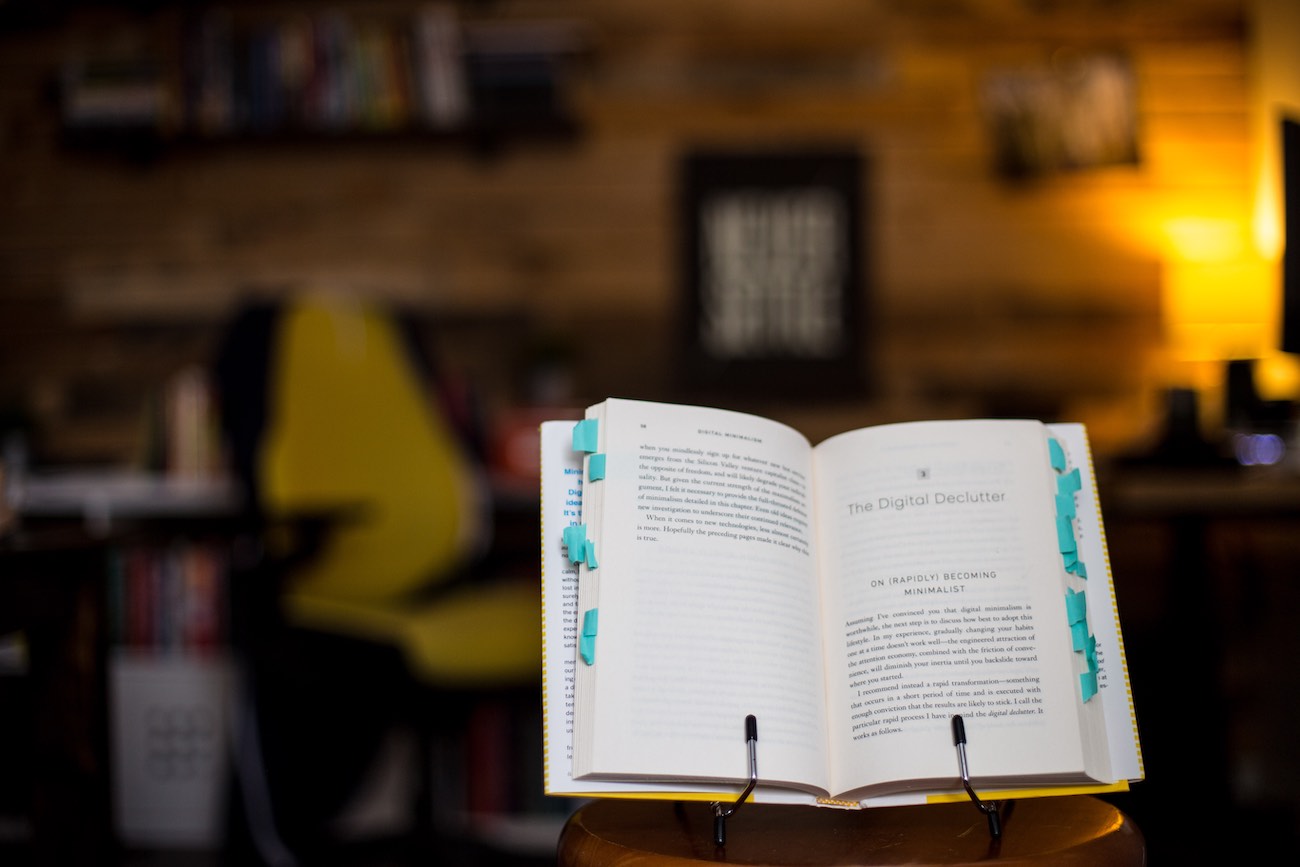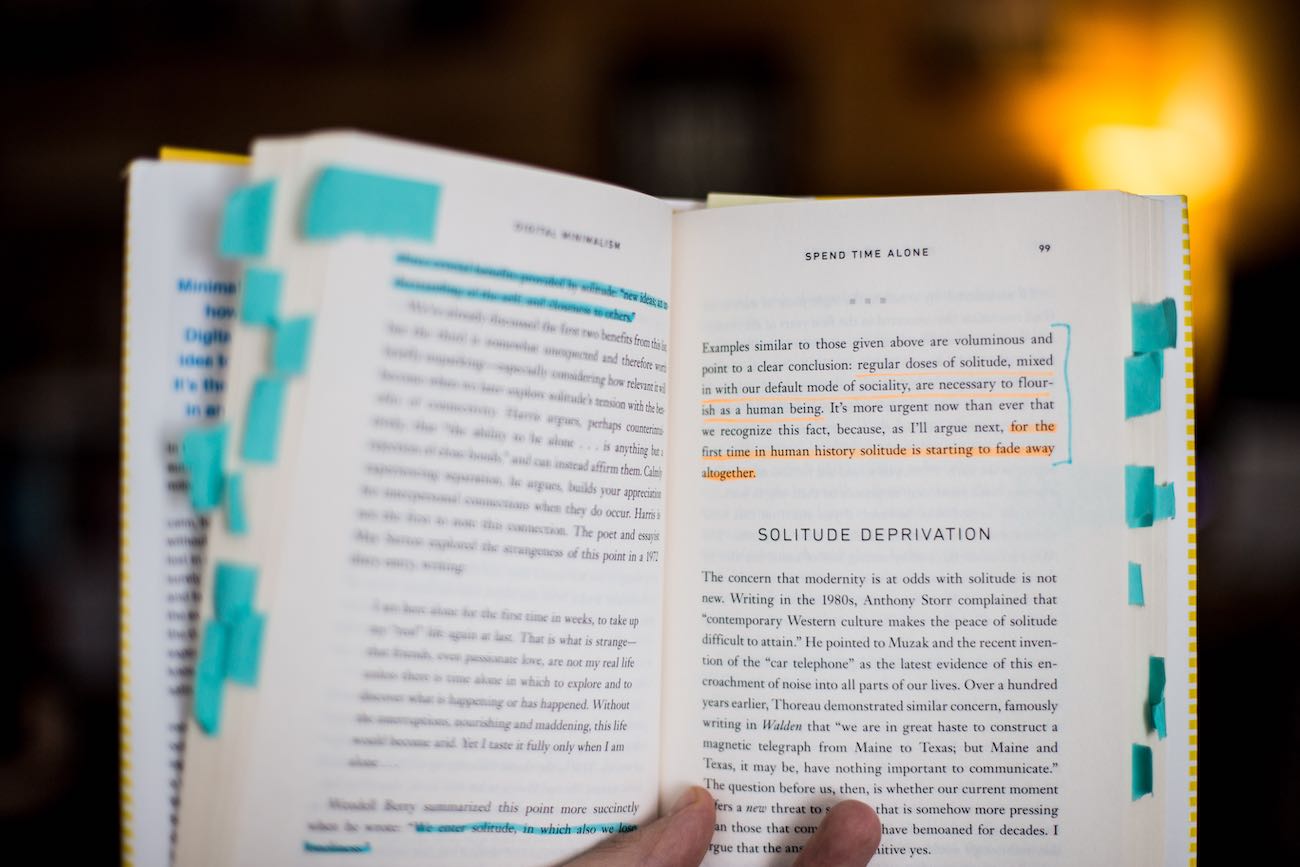Doing a Digital Declutter
In this Mindfulness Monday post, we look at how to to maximize our intentional technology use by doing a digital declutter. This post originally appeared on our sister site, The Focus Course. If you want to join in by doing your own digital declutter, check out the 30-Day Digital Declutter Kickoff.
I’ve long been a fan of Cal Newport’s work, and in 2019 he wrote a New York Times bestseller, Digital Minimalism.
When I first heard Cal start talking about the concept of the book on Jocelyn Glei’s podcast, I knew I was going to be hooked. In fact, I knew it was going to be one of those books that fundamentally changed the way I think about the world.
But I’m getting ahead of myself…
We Need Margin
In the spring of 2019, I launched into a research process to help build a new training curriculum on the topic of margin. The research was by no means exhaustive, but it was similar to taking a cold shower — a little shocking while also being quite refreshing.
The truth is, we are very overwhelmed, overstimulated, oversold, and overworked people. We need margin like we need air. A life without margin will quickly come to a screeching halt. Margin is the space between our load and our limit, so the truth is, while all of us have a measure of margin, we are in desperate need of more. Physically, emotionally, in our time, financially, and mentally.
As we know, all of these are interdependent and interconnected. When we lack margin in one of these areas, it drains another. When we have an abundance of margin in one area, others benefit as well.
I’m not here to convince you of the need for margin, because you likely already know its value. As we head into 2020, I’m taking a sledgehammer to the devices in my life that consume disproportionate amounts of this precious resource.
* * *
In December of 2017, I was reflecting back on the year as 2018 loomed on the horizon. As a relatively active person, I had spent a considerable amount of time that year training and competing in the sport of triathlon, and I thoroughly enjoyed it. But as I looked at the upcoming year and the things that were central to my vision and values, I realized triathlon was getting a disproportionate amount of my time.
I decided to stop. Yes, it was something I enjoyed. Yes, it was something that promoted a healthy lifestyle. But it was costing me enormous amounts of time, emotional, mental, and physical margin. Not to mention financial cost. One decision to cut a personal hobby instantly restored margin in every area of my life. It was an easy decision to make.
Since then I’ve identified another margin sucking culprit, but this one is especially keen on emotional and mental reserves: technology use. More specifically, the various inboxes and social feeds I’m subscribed too.
What I’ve learned over the last year, and am still learning, is the importance of a technology philosophy. In essence, what role does technology play in my life? And, is there a point in which it ceases to be helpful?
I love the way Cal Newport correlates this to an analogy with food. It’s commonplace to have a dietary philosophy. I eat these foods because a, b, and c, and I avoid these foods because of x, y, and z. We all know it’s not a good idea to live solely on fast food. Remember the Super Size Me guy?
What about digital fast food? What kind of effect does the digital equivalent of junk food have on our emotional, physical, and mental capacity?
Tristan Harris, in his 60 Minutes interview, referred to smartphones as a slot machine, and not just like a slot machine, but actually engineered like a Vegas slot machine. “Every time I check my phone, I’m playing the slot machine to see, “What did I get?” It’s not just that we need to exercise more self-control around the services we use, but that these services are being funded and engineered to capture our attention and to be addictive. Just like a slot machine.
So yeah, I think it’s a good idea to have a technology philosophy. Sticking with the food analogy, if the inputs we consume are equal to the food we’re eating to nourish our mental and emotional state, what does a healthy diet look like?
Any dietitian would tell you to avoid eating fast food on a regular basis, if ever. What would a digital dietitian tell you regarding the fast food of the internet? Occasional but limited consumption? Once a week? Once a month?
* * *
This brings me back to Cal Newport’s book, Digital Minimalism.
First off, you’re going to want to read it at some point, so go ahead and order yourself a copy.
For me, there were three big takeaways from the book.
1. Philosophy of Technology Use
Just as we need a philosophy toward the types of food we eat and why, so too do we need a philosophy regarding the types of technology we embrace and use.
Someone that avoids sugar or fast food isn’t anti-food. Just as someone that refrains from engaging with certain software or social services isn’t anti-tech.
We’ve all seen the catchy headlines promoting life hacks to get your smartphone usage under control. For lasting and meaningful change to occur, we need more than life hacks or quick tips. We need a technology philosophy that aligns with deep rooted values.
A technology philosophy is nothing more than a manifesto of how and why we use technology. If our technology use isn’t linked to our value system, then there will be no anchoring component to what types of technology we use and how often.
For simplicity, we could use Cal’s definition of digital minimalism as a working technology philosophy.
Digital Minimalism
A philosophy of technology use in which you focus your online time on a small number of carefully selected and optimized activities that strongly support things you value, and then happily miss out on everything else.
Feel free to adopt this or come up with your own. In the end, you want to have a statement of sorts to come back to when evaluating the technologies you use. It should give you a sense of true north with regards to how you use tech.

2. The Digital Declutter
It can be hard to obtain a sense of clarity around our technology use. When stuck in the cyclical patterns of checking inboxes, it can be a challenge to disentangle ourselves enough to define what our essential technology really is, which is what the digital declutter is for. More or less, it’s a digital detox that leads to lasting change.
The digital declutter removes all the extra (optional) technologies we’ve stuffed our life full of long enough to break free of their addictive nature. Then, as we begin to experience the relief of mental margin, we fill the vacant time with activities that bring lasting satisfaction.
Cal outlines the declutter process well in Digital Minimalism. (I highly recommend reading at least chapter 3 on The Digital Declutter)
The Digital Declutter Process (From Digital Minimalism)
- Put aside a thirty-day period during which you will take a break from optional technologies in your life.
- During this thirty-day break, explore and rediscover activities and behaviors that you find satisfying and meaningful.
- At the end of the break, reintroduce optional technologies into your life, starting from a blank slate. For each technology you reintroduce, determine what value it serves in your life and how specifically you will use it so as to maximize this value.
There are a couple things of importance in here.
-
The point of the digital declutter is lasting change on the other side. From the experience of hundreds that have gone through the process, those that dropped out early were those that treated the declutter simply as a break from technology. The declutter removes the cloudiness of technology so that we can decide which ones we actually want to keep after the 30 days is finished.
-
Another key to succeeding the 30 days is to intentionally decide what you will do during the declutter to fill the void. If you don’t have an activity to fill the empty space, you are more likely to not finish the declutter. Make a list of activities you will turn to instead of the optional technology you are forgoing.
To summarize, the digital declutter is a tool meant to aid the process of selectively weeding out unnecessary technologies that do not align with our technology philosophy. The digital declutter will not be effective if viewed as a break from technology. It is meant to lead to change.
3. Solitude Deprivation
Finally, the most fascinating section of Digital Minimalism for me was on the topic of solitude.
The smartphone moved us into a truly unprecedented era of human history.
It’s not just the power of the internet in our pockets, and not just the ability to communicate with people on the other side of the planet. But for the first time in human history, we have the ability to completely remove solitude from our daily existence. A fundamental element of being human for thousands of years is now being threatened to near extinction — the ramifications of which we are only just beginning to understand.
Solidtude Deprivation
A state in which you spend close to zero time alone with your own thoughts and free from the input from other minds.

To get a clearer grasp of the implications of this change, I highly recommend reading chapter 4 (Spend Time Alone) of Digital Minimalism.
The ongoing research behind the importance of solitude is compelling, but in short: “Regular doses of solitude, mixed in with our default mode of sociality, are necessary to flourish as a human being.”
This isn’t just an optional luxury of life we’ve endangered. Moments of solitude are essential to our human experience. By removing it altogether we are altering fundamental aspects of the human brain — not to mention causing anxiety and stress like we’ve never seen before.
The 30-Day Digital Declutter
If you want to jump in and do your own digital declutter, check out the kickoff post here.
There is no formal group, email, or official format, but all are welcome.
The goal is to make lasting change for a simplified digital life. This isn’t just a break from social media or an excuse to ignore phone calls and texts. It’s a reevaluation of the technologies we allow in our life on a day-to-day basis. The declutter is a necessary detox to make clear decisions about our technology use without being influenced by our current default behaviors.
- Starting TODAY, Monday, Jan 13th and concluding Tuesday, Feb 11th
- Following Cal Newport’s Digital Declutter Outline
- There will be no social tags (because it’s a digital declutter)
We’d love to have you join us as we reclaim our attention and refocus in 2020!
